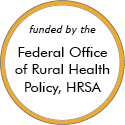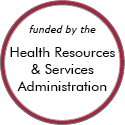Rural Project Examples from FORHP Rural Health Care Services Outreach Grant Program
Promising Examples
Health without Borders


Updated/reviewed January 2025
- Need: To improve the health of communities in the south central region of New Mexico.
- Intervention: A program was developed to address diabetes prevention and control, behavioral healthcare, and immunization in Luna County.
- Results: During the program, 1,500 immunizations were distributed, baseline measurements of participants improved, and 935 new patients were seen for behavioral health issues.
Nurse Navigator and Recovery Specialist Outreach Program

Updated/reviewed December 2024
- Need: To properly address and treat patients who have concurrent substance use disorders and chronic healthcare issues.
- Intervention: A referral system utilizes community health workers (CHWs) in a drug and alcohol treatment setting. A registered nurse helps with providers' medication-assisted treatment programs.
- Results: This program has reduced hospital emergency visits and hospital readmissions for patients since its inception.
Cross-Walk: Integrating Behavioral Health and Primary Care

Updated/reviewed May 2024
- Need: To address and treat substance use disorder (SUD) and depression in the Upper Great Lakes region.
- Intervention: Cross-Walk, a program that integrates behavioral healthcare into primary care services, was developed in Michigan's Marquette County.
- Results: The collaborative efforts strengthened care management services in local healthcare facilities as primary care patients were referred to a behavioral health specialist.
Northeast Louisiana Regional Pre-Diabetes Prevention Program

Updated/reviewed March 2024
- Need: To prevent or slow the progression of diabetes for at-risk residents in Rural Northeast Louisiana.
- Intervention: The North Louisiana Regional Alliance developed a program that offered screenings, education, and an intense course for participants throughout the Northeast Louisiana region to lower the risk of diabetes.
- Results: The program saw an overall decrease in blood sugar levels in residents who participated in their initiatives.
Healthy Connections, Inc. Healthy Families Arkansas

Updated/reviewed December 2022
- Need: High poverty rates and lack of access to healthcare make caring for unborn and newborn children difficult for young mothers in Arkansas's Polk and Garland Counties.
- Intervention: An Arkansas-based program provides a national healthcare service to expectant and young mothers. Prenatal check-ups, education, transportation, well-baby checks and child immunizations are all provided by the Healthy Connections, Inc.
- Results: The program's results demonstrate an increase in first trimester prenatal care rates and child immunization rates, as well as a dramatic decrease in confirmed cases of child abuse.
School-Based Health Center Dental Outreach

Updated/reviewed July 2020
- Need: To improve the oral health status of children ages 3 to 17 living in rural areas of Louisiana.
- Intervention: School-based nurse practitioners perform oral health assessments, apply fluoride varnishes when indicated, and make dental referrals, with completion rates of the latter tracked by dental case managers.
- Results: Significant numbers of school children are receiving oral health examinations, fluoride varnish applications, and receiving care coordination to improve numbers of completed dental appointments.
Youth4Health

Updated/reviewed December 2019
- Need: To educate youth about obesity and healthy lifestyle choices.
- Intervention: An educational program about healthy living was implemented in Lincoln and Claiborne Parishes in Louisiana for youth ages 9-18.
- Results: Youth4Health program produced greater awareness and participation in healthier lifestyles by target youth and their families, as well as church congregations.
Other Project Examples
Mobile Integrated Healthcare Network (MIHN)

Updated/reviewed November 2025
- Need: To bring preventive care and other services to rural Missouri patients with chronic illnesses and difficulties accessing primary care.
- Intervention: Community paramedics make home visits and provide basic care, home assessments, and medication reconciliation and facilitate telehealth visits.
- Results: Patients experienced improved access to care, health status, and compliance with medication regimens along with increased patient engagement, satisfaction, and access to community resources.
Win With Wellness

Updated/reviewed October 2025
- Need: To reduce risk of obesity and chronic disease in rural northwest Illinois.
- Intervention: Win With Wellness (WWW) collaborated with community organizations and worksites to improve physical activity and eating behaviors and reduce weight among adults using a multi-component approach.
- Results: From 2015 to 2018, the two participating counties initiated 28 Take Off Pounds Sensibly (TOPS) groups with 367 participants. In the second round of funding, WWW recruited 183 participants for 9 TOPS groups and 8 community Heart-to-Heart sites.
Cold Water Safety Children and Youth Educator Program

Updated/reviewed April 2025
- Need: Drowning was a leading cause of death for children in Alaska.
- Intervention: Cold Water Safety and Survival for Educators workshops were developed in 1998, with help from a 4-year federal grant, to train educators to provide education and hands-on skills for school children and members of the public.
- Results: The safety program was integrated into about 79% of Alaskan school curriculum and schools in other states, helping to train hundreds of educators and thousands of children on the importance of cold water safety.
